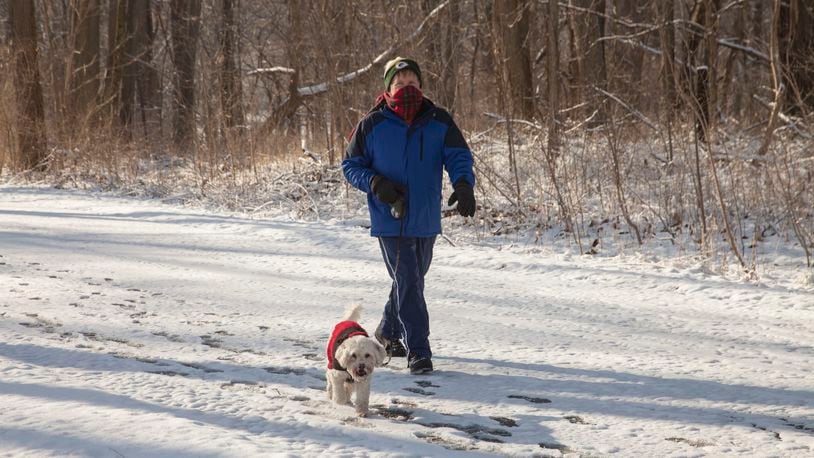With COVID case numbers a significant concern, outdoor fitness continues to be among the safest ways to stay active – not to mention fun.
“This time of year, I love to get out and take a hike or a bike ride in the cooler weather,” said Jordan Hart, Five Rivers MetroParks outdoor recreation program specialist.
Motivation and preparation are key.
“The hardest part of cold weather hiking is getting off the couch and getting to the trailhead,” said Andy Niekamp of the Dayton Hikers. “It takes motivation to leave a warm house on a cold day. But once you are at the park, you’ll find that cold weather hiking can be quite pleasant and the outdoors can be very beautiful. But it’s important to be prepared.”
Local outdoor enthusiasts weigh in on how to enjoy winter outdoor adventure safely and happily.
Jordan Hart, Five Rivers MetroParks
* Dress in layers as you head out, so you can put more on if you get cold or take some layers off as you heat up so you don’t sweat.
* Catch a sunset if you can. It’s always a good idea when heading out in the late afternoon to bring a light in case you get caught out later than you anticipated.
* With the shorter days, one of the advantages is you can take a night hike earlier with a headlamp. The gates at the parks are open until 8 p.m.
* Take some hot beverages in the thermos to warm up, like apple cider or hot chocolate.
Kristy Matheson, Adventure Chicks
* Layering is best – moisture-wicking shirts and bottoms are great for base layers, and you can add from there. Avoid a super heavy coat, as movement generates warmth quickly.
* Trekking poles are especially helpful for snowy or icy conditions and Ice Trekkers to put on the bottom of your shoes or boots are helpful for icy conditions.
* I would start off doing a shorter hike to see how you do and then go from there.
* Warm head gear, a neck gaiter and layered wool socks are needed if it’s cold. If it’s really cold, I’ve also added hand and toe warmers and that has made a huge difference in comfort. It may take a few more minutes to plan for outdoor winter activity, but some of my most memorable moments have been in weather that I used to completely avoid.
Credit: Andy Niekamp
Credit: Andy Niekamp
Andy “Captain Blue” Niekamp, Dayton Hikers
* First, check the weather forecast before heading outdoors. Know what conditions to expect.
* When dressing for cold weather, outside activities remember the three W’s of layering. The wicking layer is your base layer. Choose a thin synthetic fabric like nylon. It carries moisture away from your skin and dries easily. The warmth layer is your middle layer. Choose fleece, nylon or wool. This insulating layer works by trapping air in spaces that hold body warmth. The weather layer is your outer layer. It protects you from the elements like snow, rain and wind. This layer is typically synthetic fabric and should be waterproof and breathable. Avoid cotton clothing, even for socks. When cotton gets wet it loses its insulating properties and is heavy.
* It’s important to drink lots of water during cold weather activities. A dehydrated person has a higher risk of exhaustion because their body has to work harder to circulate their thicker blood. Bring high energy snacks too. Fruit, granola and trail mix are my favorites.
* Bring along a wool or fleece hat and gloves. Don’t forget lip balm.
Laurel Slate, Dayton Hikers
* Layering is important – experiment with the number of layers and the thickness to see what works best for you in various temperatures.
* Use a day pack to put any clothing you discover is too much to wear while hiking and to carry items you think you might need later.
* I wear convertible mittens. These look like mittens but you can pull back the top layer and they are fingerless gloves. I like these because my hands get hot when hiking with poles.
* In the winter, carrying water bottles inside your daypack or in a pocket inside your coat works better than a bladder as the hose likes to freeze in the cold. Always carry some snacks because food is the fuel that helps keep you warm.
“With the right gear, you can really get out and enjoy nature in almost any temperature this winter,” Matheson said. “Beauty can be found in all seasons, and it’s a joy to find it.”
About the Author
